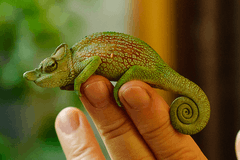Strange-nosed chameleon
| Strange-nosed chameleon | |
|---|---|
 | |
| Strange-nosed chameleon (Kinyongia xenorhina) | |
| Scientific classification | |
| Kingdom: | Animalia |
| Phylum: | Chordata |
| Class: | Reptilia |
| Order: | Squamata |
| Family: | Chamaeleonidae |
| Subfamily: | Chamaeleoninae |
| Genus: | Kinyongia |
| Species: | K. xenorhina |
| Binomial name | |
| Kinyongia xenorhina (Boulenger, 1901) | |
| Synonyms | |
|
Kinyongia xenorhinum | |
The strange-nosed chameleon (Kinyongia xenorhina) is a chameleon native to the rainforests of the Ruwenzori Mountains of western Uganda and eastern Democratic Republic of the Congo.
The strange-nosed chameleon is named for the large protuberance extending from the top of its snout, particularly prominent on the males of the species. This feature is composed of two separate plates extending outwards from either side of the snout and merging at the end. This feature has also earned it the alternate common name, single welded-horn chameleon. It also has a very high casque (a helmet-like structure towards the back of the skull). The head and casque are covered with enlarged, plate-like scales.
Strange-nosed chameleons are olive to brown in color, sometimes with lateral orange or blue coloration. Males range more towards olive and females more towards brown. They can reach a length of 11 in (280 mm), making them one of the larger members of the Kinyongia genus. They have among the sharpest "teeth" and longest claws of any chameleon species.
The strange-nosed chameleon has rarely been bred in captivity, and is, due to its restricted distribution which places it at risk from habitat destruction and overcollecting for the live animal trade, considered threatened.[1]
References
- ↑ Spawls, S., K. Howell, R. Drewes, and J. Ashe. (2002). A Field Guide to the Reptiles of East Africa. Academic Press. ISBN 0-12-656470-1
- Pollak, E. (2003). Bradypodion xenorhinum. adcham.com.